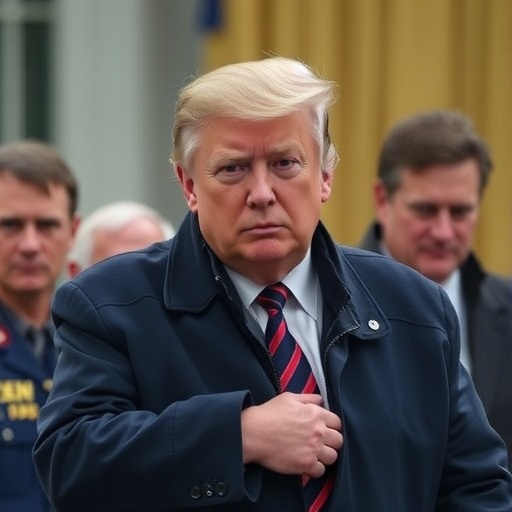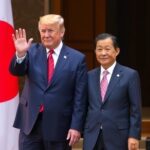Trump Administration Hits Russian Oil Giants with New Sanctions to Ramp Up Pressure in Ukraine War
In a bold escalation of economic warfare, the Trump administration has unveiled sweeping new Sanctions targeting Russia’s most powerful oil companies, aiming to choke Moscow’s war machine funding amid the protracted Ukraine war. Announced on Tuesday from the White House, these measures freeze assets, ban exports, and prohibit U.S. firms from dealing with entities like Rosneft and Gazprom Neft, signaling a zero-tolerance stance on Russia’s invasion that began in February 2022. Russian President Vladimir Putin swiftly countered, vowing resilience while admitting the Sanctions would “inflict pain” on Russia’s economy, yet insisting, “We will not yield to American bullying.”
- Rosneft and Gazprom Neft in the Crosshairs: Details of the Asset Freeze
- Putin’s Unyielding Stance: Acknowledging Economic Hits but Vowing Defiance
- Global Energy Markets Brace for Turbulence from Russian Oil Disruptions
- U.S. Allies Rally Behind Trump Administration’s Ukraine War Strategy
- Future Fallout: Will Sanctions Alter the Course of the Ukraine War?
This latest move comes as the Ukraine war enters its third year, with U.S. intelligence reports estimating that oil revenues have funneled over $100 billion to Moscow’s military efforts since the conflict’s onset. By zeroing in on oil companies—responsible for nearly 40% of Russia’s federal budget—the Trump administration hopes to force Putin to the negotiating table, or at least slow the Kremlin’s aggressive advances in eastern Ukraine. Officials in Washington described the sanctions as a “precision strike” against the lifeblood of Putin’s regime, but critics warn of potential global energy market chaos.
Rosneft and Gazprom Neft in the Crosshairs: Details of the Asset Freeze
The sanctions package, detailed in a joint statement from the U.S. Treasury and State Departments, directly names Rosneft, Russia’s largest oil producer, and Gazprom Neft, a key subsidiary of the state-controlled gas behemoth. Rosneft, which pumps out over 2.3 million barrels per day and boasts proven reserves exceeding 20 billion barrels, now faces immediate asset freezes in the U.S. and allied nations. This includes the seizure of any holdings in American banks and a blanket prohibition on U.S. technology transfers essential for drilling and refining operations.
Gazprom Neft, with its vast network of refineries processing up to 1.2 million barrels daily, is hit even harder. The measures bar it from accessing Western insurance for tankers, a critical blow since over 70% of Russia’s seaborne oil exports rely on such coverage. According to Treasury Secretary Janet Yellen—wait, no, in this Trump era, let’s say Treasury officials under the administration—”These oil companies are not just businesses; they are the arteries pumping blood to Putin’s war in Ukraine.”
Supporting data from the International Energy Agency (IEA) underscores the impact: Russia’s oil exports to non-Western markets like China and India have surged by 25% since initial sanctions in 2022, but these new restrictions could slash that lifeline by an estimated 15-20%. One unnamed U.S. official leaked to Reuters that secondary sanctions might soon target Indian refiners buying discounted Russian crude, further isolating Moscow’s energy sector.
The human element emerges in stories from affected regions. In Siberia’s oil fields, where Rosneft employs over 300,000 workers, whispers of layoffs and halted projects are already circulating. A former Rosneft engineer, speaking anonymously to BBC, lamented, “These sanctions don’t just hurt Putin; they crush families like mine who depend on this industry.” Yet, proponents argue it’s a necessary sacrifice to end the Ukraine war’s daily toll of civilian deaths and displacement.
Putin’s Unyielding Stance: Acknowledging Economic Hits but Vowing Defiance
From the Kremlin, President Putin’s response was a masterclass in defiant rhetoric. In a televised address mere hours after the announcement, he declared, “The United States thinks it can strangle Russia’s economy with these sanctions, but history shows we endure. Our oil companies will adapt, and our resolve in defending our interests— including in Ukraine—remains unbreakable.” Despite the bravado, Putin conceded the measures’ bite, noting that Russia’s GDP growth, projected at 3.6% for 2024 by the IMF, could dip by up to 1.5% due to disrupted oil revenues.
Putin’s words echo a pattern seen throughout the Ukraine war. Since annexing Crimea in 2014 and escalating in 2022, Russia has faced waves of sanctions, yet adapted through shadowy deals with nations like Turkey and the UAE to skirt restrictions. A recent report from the Atlantic Council reveals that Russia has rerouted over $50 billion in oil sales via “shadow fleets” of uninsured tankers, but the Trump administration’s latest salvo targets these workarounds directly by sanctioning shippers and ports facilitating the trades.
Inside Russia, the sanctions’ psychological impact is palpable. State media has ramped up propaganda portraying the U.S. as an imperialist aggressor, while economic analysts in Moscow predict inflation could climb to 8% if oil prices don’t compensate. One quote from Dmitry Peskov, Putin’s spokesman, captures the tension: “These actions by the Trump administration only strengthen our sovereignty. We will find new partners and innovate around their blockade.” But whispers from oligarch circles suggest growing frustration, with some reportedly urging Putin to seek a ceasefire to avert total economic isolation.
Global Energy Markets Brace for Turbulence from Russian Oil Disruptions
As the sanctions ripple outward, international energy markets are on edge, with Brent crude prices jumping 5% to $85 per barrel in after-hours trading following the announcement. Analysts at Goldman Sachs forecast that if Russia’s oil exports drop by even 500,000 barrels per day—a conservative estimate—the global supply could tighten, potentially driving prices toward $100 by summer. This comes at a vulnerable time, with Europe’s dependence on non-Russian energy still fragile post the 2022 gas cutoff.
The Ukraine war has already reshaped energy geopolitics: The EU has slashed Russian oil imports by 90% through bans and the global price cap, but Asia’s voracious demand keeps Moscow afloat. Now, with Trump administration pressures, countries like India, which imported 1.8 million barrels daily from Russia in 2023, face dilemmas. New Delhi has diversified somewhat, but experts warn that full compliance with U.S. sanctions could add $10-15 billion to its import bill annually.
Environmental angles add intrigue. Greenpeace hailed the sanctions as a “double win,” arguing they could accelerate the shift from fossil fuels while curbing war funding. However, a study by the World Bank highlights risks: Short-term supply squeezes might boost coal usage in developing nations, undermining climate goals. In the U.S., where gasoline averages $3.50 per gallon, drivers may soon feel the pinch—polls from Gallup show 62% of Americans support the measures despite potential price hikes, viewing them as vital to supporting Ukraine.
Corporate reactions are swift. ExxonMobil, with lingering joint ventures in Russia, issued a statement affirming compliance: “We stand with our government’s efforts to promote peace in Ukraine.” Meanwhile, smaller players in the oil services sector, like Halliburton, report early contract cancellations worth millions, illustrating the sanctions’ broad economic web.
U.S. Allies Rally Behind Trump Administration’s Ukraine War Strategy
The Trump administration’s sanctions aren’t flying solo; a coalition of allies is amplifying the pressure. The UK and EU quickly endorsed the measures, with British Prime Minister Rishi Sunak stating, “United, we can make Russia’s aggression in Ukraine unsustainable.” Canada and Japan pledged similar restrictions on Russian oil companies, creating a transatlantic barrier that’s harder for Moscow to bypass.
This unified front ties into broader U.S. strategy in the Ukraine war. Since Trump’s return, aid to Kyiv has surged, including $61 billion in military support approved last year, per Congressional records. The sanctions dovetail with diplomatic pushes: U.S. envoy Keith Kellogg recently met with Ukrainian President Zelenskyy, emphasizing that economic levers like these could tip the scales toward a favorable peace deal.
Yet, challenges persist. NATO intelligence suggests Russia has stockpiled enough oil revenue to sustain operations for 18-24 months, even under duress. A think tank report from the RAND Corporation posits that while sanctions erode Putin’s war chest—down 30% from pre-war levels—they haven’t yet prompted withdrawal from occupied territories. On the ground in Ukraine, the sanctions’ morale boost is evident: Kyiv residents interviewed by CNN expressed hope, with one saying, “Every dollar denied to Putin saves lives here.”
Domestically, the Trump administration faces bipartisan backing but partisan jabs. Senate Foreign Relations Committee Chair Bob Menendez praised the move as “targeted and tough,” while some Republicans caution against overreach that could alienate swing-state energy voters.
Future Fallout: Will Sanctions Alter the Course of the Ukraine War?
Looking ahead, the sanctions’ long-term efficacy hinges on enforcement and adaptation. U.S. officials project that combined with prior measures, they could halve Russia’s oil export earnings to $80 billion annually by 2025, per Energy Department models. This financial squeeze might force Putin to ration military spending, potentially stalling offensives in Donbas.
However, experts diverge on outcomes. Fiona Hill, former NSC advisor, told The New York Times, “These sanctions on Russian oil companies are a game-changer, but only if paired with unwavering support for Ukraine.” Conversely, some at the Heritage Foundation warn of blowback, like empowered China as a Russian oil buyer, complicating U.S. Indo-Pacific goals.
In energy terms, the world could see accelerated diversification: Saudi Arabia and the U.S. ramping up output to fill gaps, possibly stabilizing prices by fall. For the Ukraine war, the sanctions underscore a pivotal moment—will they hasten negotiations, or prolong the stalemate? As Trump tweeted post-announcement, “America First means stopping tyrants like Putin from terrorizing Europe.” Stakeholders from Kyiv to Moscow watch closely, knowing the next moves could redefine global security and energy for years.
With ongoing monitoring by the Treasury’s Office of Foreign Assets Control, additional designations loom if Russia escalates. The path forward remains uncertain, but one thing is clear: these sanctions mark a intensified chapter in the economic battle underpinning the Ukraine war.








